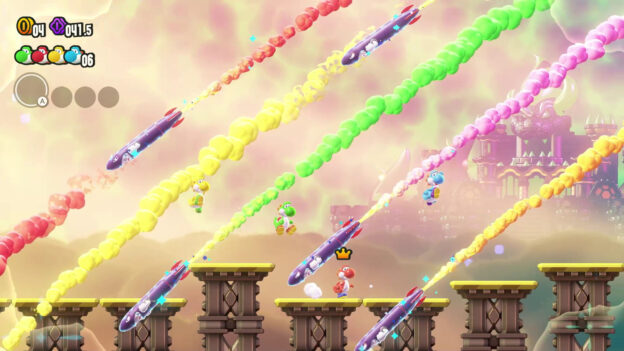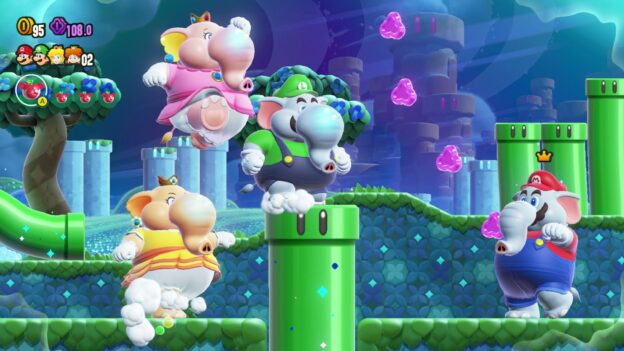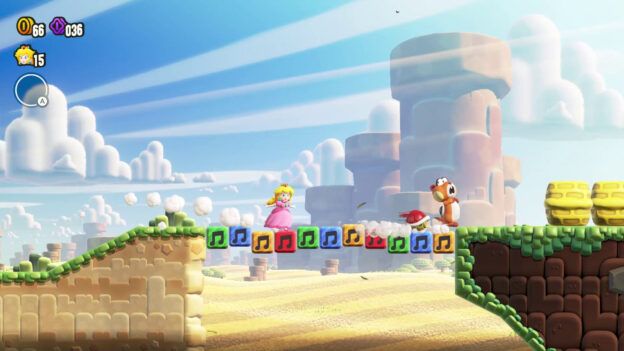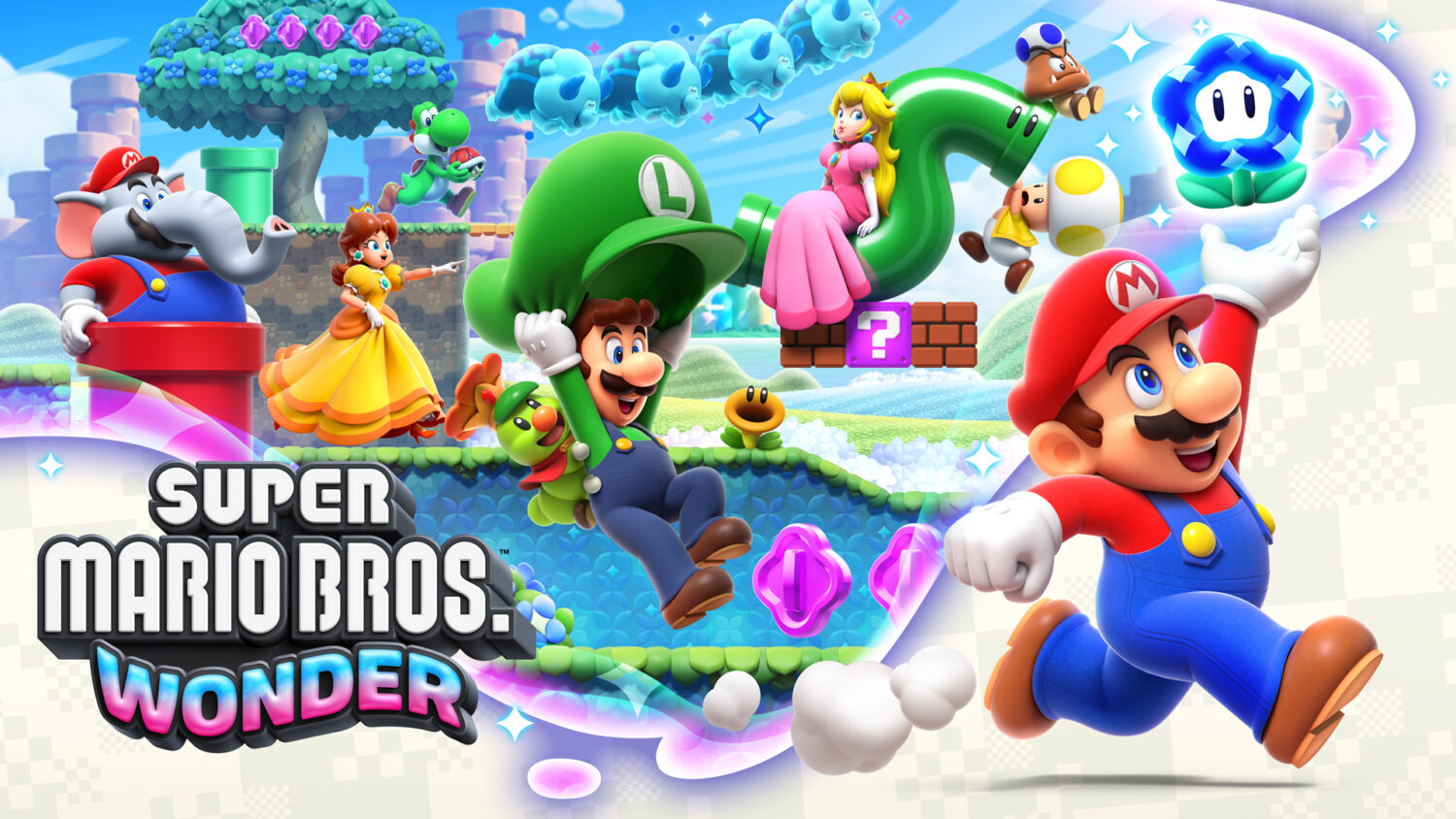Super Mario Bros. Wonder is finally here after…well, actually only a few short months since it was announced. Having said that, we’ve been waiting ten long years for a new entry in the 2D Mario series, not counting the Deluxe version of New Super Mario Bros. U. And, oh boy, has it been worth the wait.
Although it was surprising to see a new Mario adventure after all this time, it also marked a very different approach for the series.
Gameplay

Simply put, Super Mario Bros. Wonder is a platformer. If you’re familiar with Mario’s side-scrolling mechanics, you’ll feel at home here. Having said that, a lot has changed, giving Wonder a fresh feel for the first time in a long time.
One notable absence in multiplayer mode is the lack of character collision. Yes, the bump mechanic is gone, for better or worse. While it could accidently foil that perfect jump when someone gets in your way, it was also useful to bounce off each other to reach high places. Wonder’s approach took a little getting used to, but it soon became the norm for me.
Another change is the approach to the world map. Unlike previous platformers, Mario and co. can stroll around between levels à la Super Mario 3D World. It’s a nice touch that adds some freedom to proceedings. You can tackle most worlds in any order you like, though you’ll need to finish each one in order to reach Bowser.
Boss fights are hit and miss for me. I enjoyed more screen time for Bowser Jr., and I didn’t miss Boom Boom or the Koopalings (though I look forward to them reappearing in a future game; they have their place). However, the fights were too easy for this long-time player, especially if you have the Elephant Suit! You can whip Bowser Jr. with your trunk until he’s ready to be jumped on.
The other type of boss battle features a mechanical jaw at the end of a conveyor belt. These look amazing and feel fresh and intimidating at first. They’re just over too quickly, especially with multiple players. For context, I consider myself to be quite adept when it comes to platformers (it’s my genre of choice, after all), so don’t necessarily be put off by my comments. The fights feel fresh, look great, and will provide a challenge for mid-level players. And there are other challenges.
Levels now feature a difficulty rating. While I don’t need these, they help players identify which levels to tackle next, or those to avoid if they can. Personally, I was excited by the four and five-star varieties, which caused some consternation upon first try. I love the challenge, though, and I’m happy to see a mix of easy and tricky levels to keep players like myself engaged.
The biggest difference with Wonder is, well, the Wonder Flowers themselves. These appear in every main level, and collecting them alters the layout, music, abilities, colors, you name it! You could be chased by a gigantic creature through a maze; maybe the screen will rotate; perhaps sky and sea will swap places; or you could even morph into a completely different creature yourself. Each is genuinely exciting, providing a fun departure from the norm in very creative ways.
There are other moments of genuine wonder that don’t come from the chaotic Wonder Flower. Maybe there’s a pipe that elicits Lakitu clouds for you to ride in. Perhaps you’ll find Captain Toad hidden on the world map. Or you could discover a mirage in the desert. This game has a lot of surprises in store, keeping you on your toes and eager for more.
Characters

One of the selling points for Super Mario Bros. Wonder is the vast array of characters available. Mario and Luigi are present and accounted for, of course, but players can now adopt the persona of Princess Daisy or Yoshi. Other returning favorites include Nabbit and Princess Peach, along with both Yellow and Blue Toad.
Having multiple Toads is a plus, though it’s unclear as to where the original Toad—who is red in color—has disappeared. It’s a minor thing, but why is Toad now stuck being blue or yellow? Red Toad is an obvious choice, but there are also green and purple varieties out there. Perhaps I’m being picky, but I’d love to see a general “Toad” option that allows a color palette swap à la Mario Kart’s Shy Guy and Yoshi character selections.
Twelve characters seems like quite a treat for players. And, in some ways, it is. There’s a catch, though; five of the twelve characters are invincible.
It’s not necessarily a new mechanic; Nabbit exhibited this power last time we saw him. It’s actually fine in principle, encouraging players of all skill levels to join in and have fun. What might have been even more accessible would be allowing any player to toggle invincibility on or off for any character. Why can’t my child be an invincible Toad or Luigi? Conversely, why can’t a more skilled player don the role of Yoshi or Nabbit? It seems like a missed opportunity. I won’t ever play as Yoshi or Nabbit because I like the challenge, limiting my options significantly. At least we can play with four players without relying on invincibility this time.
Music

The music is a treat, as it is with every Mario title. Some outings like Odyssey and Galaxy excel in this area, but let’s not forget the classic tunes that came from Mario’s original 2D outing. In Wonder, the music is fresh and new, fun and bouncy. It’s part and parcel of everything this title represents.
The sound effects are also worth noting. Mario and friends are a lot more lively. Mario still says “wahoo” (even if he is voiced by newcomer Kevin Afghani), but each character has their own little catchphrase. I particularly enjoy the way they wave and say goodbye to the Poplins at the end of each level.
Badges
I’ll admit I was skeptical about the inclusion of badges when they were first announced. I wasn’t fond of the idea that Mario needed enhancements to complete levels. It felt like cheating. Having now spent a lot of time with the game, I’m completely turned around on the subject.
Most badges add to the experience, providing fun, extra mechanics that almost feel like substitutes for suits. There are no flying suits in this outing (like Tanooki, Squirrel, Helicopter, or Cape), which are sorely missed. There’s nothing like soaring through the sky as Racoon Mario! However, badges like the Parachute Cap help fill this void. It provides a floating ability that lets you soar across the screen, a little like the Squirrel suit.
But not all badges are as user-friendly. Many are completely irrelevant. I’m talking about badges like Invisibility, which was tricky to obtain and difficult to use in a level. The Rhythm Jump badge, on the other hand, is super fun. This one adds a background sound, doling out coins when you jump to the beat. It adds a completely different aspect to Mario’s platforming, but isn’t ideal for tough levels or boss fights, mind you.
Collecting badges is another favorite pastime of mine now. Some are easy to spot via challenges, others come courtesy of shops in exchange for gems. Others are hidden away in secret levels. Collecting them all is a necessary obsession for this player.
Overall opinion
Overall, Super Mario Bros. Wonder is the Mario game we didn’t know we wanted. This long-running series is no stranger to new mechanics; think of Yoshi’s introduction in Super Mario World or the first time Mario could fly in Super Mario Bros. 3. Wonder adds to the list with a completely fresh take on the series while staying true to its roots. Simply put, it’s a joy to play. Mario fans will relish this outing.
Just don’t make us wait another ten years please, Nintendo.
We also spoke about Super Mario Bros. Wonder on our weekly podcast.
Review: Super Mario Bros. Wonder (Nintendo Switch)
Great
Super Mario Bros. Wonder is the Mario game we didn’t know we wanted. This long-running series is no stranger to new mechanics and Wonder adds to the list with a completely fresh take while staying true to its roots. Simply put, it’s a joy to play.


